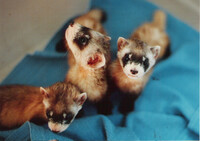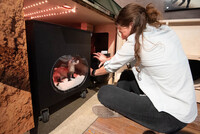The black-footed ferret exhibit at American Prairie's National Discovery Center in Lewistown, Montana, just opened to the public on Nov. 14. When I went to Montana in September to visit American Prairie, their newest ambassador had just arrived from the U.S. Fish and Wildlife Service's National Black-Footed Ferret Conservation Center in Colorado, and I got to see it. Black-footed ferrets are one of North America's most endangered mammals, so they are bred and prepared for reintroduction through a National Black-Footed Ferret Recovery Program.
In addition to the Colorado Center, there are four zoos that work together on a Species Survival Plan. The Louisville Zoo near where I live in Kentucky happens to be one of the zoos that is part of the captive breeding program for this endangered species.
Louisville Zoo's head ferret keeper, Chris Florence, welcomed me to their BFF conservation center. I watched through the office window while Chris donned a mask and opened a kennel fixed with a box below that mimics a prairie dog burrow. A curious ferret poked its head out eager to be fed.
Louisville has been part of the captive breeding program for 35 years and has provided over 850 ferrets for reintroduction across the Great Plains. But the ferrets first go through a transition period where they have to get used to being in the wild. "We call it ferret boot camp," Chris said.
Black-footed ferrets have to be conditioned to living around prairie dogs to give them the best chance of survival. Facilities for this are established on F. E. Warren Air Force Base in Wyoming and Colorado's Pueblo Chemical Depot which was once part of the Army, making "boot camp" an apt descriptor.
Chris explained that "boot camp" consists of releasing ferrets in outdoor pens where there are active prairie dog towns. "They have 8-foot concrete footers in the ground," Chris said, so the prairie dogs can't expand their towns beyond the pens. And the ferrets? They don't dig. "They let the prairie dogs do all the work." Chris said. BFFs rely on prairie dogs for both shelter and food.
Before being released into the wild, BFFs have to "basically prove they can hunt in one of those pens," Chris said. And if they can't? They become good candidates for ambassadorship, like our new friend at American Prairie's Discovery Center.
Ecosystems work best when all the pieces are present, and the black-footed ferret is a missing piece in America's Great Plains because of humans. Just one black-footed ferret needs over 100 acres of prairie dog towns to support it. They eat about one prairie dog every three days, and prairie dogs now occupy only 2% of their historic range. As I wrote in a previous column, prairie dogs have long been considered an agricultural pest on working lands, and they have an extensive history of being the target of government-sponsored extermination efforts. To restore the endangered BFF means we must restore prairie dog habitat.
This means also contending with the plague — yes, that plague. While some people poison prairie dogs or shoot them, they are also up against sylvatic plague. It's called sylvatic plague when it affects animals. Once it jumps to humans, it is called bubonic plague. The plague arrived in North America via infected rats on steamships in the late 1800s, and now all it takes is a bite from an infected flea to take down huge swaths of the prairie dog population.
Conservationists treat prairie dog towns for fleas to minimize plague risks while also cooperating with ranchers to translocate prairie dogs instead of exterminating them. Conservationists hope these approaches will bolster prairie dog numbers and support reintroduction of black-footed ferrets on the prairie.
Under the 1966 Endangered Species Preservation Act, the very first list of threatened and endangered species was created. Black-footed ferrets were on that list and remain there today.
Over the years, Chris has seen firsthand the positive effects of supporting prairie dog habitat. It reminded him of the much-lauded reintroduction of wolves to Yellowstone National Park. Wolves altered Yellowstone's landscape. A healthy population of prairie dogs has the same effect. "When I went out to Colorado to release ferrets last November," Chris said, "I started looking around." He saw deer tracks everywhere. The deer came back because of the prairie dogs. So did the foxes, the badgers, the elk and the burrowing owls. Prairie dogs increase grassland nutrients and aerate the soil through their burrowing, grazing habits and waste. Chris said he even saw three golden eagles on his trip. Prairie dogs aren't just vital for the survival of the endangered black-footed ferret; their existence is also vital for more than 100 other species.





Do you know anyone who's doing cool things to make the world a better place? I want to know. Send me an email at [email protected]. Also, stay in the loop by signing up for her weekly newsletter at WriterBonnie.com. To find out more about Bonnie Jean Feldkamp and read features by other Creators Syndicate writers and cartoonists, visit the Creators Syndicate website at www.creators.com.






View Comments